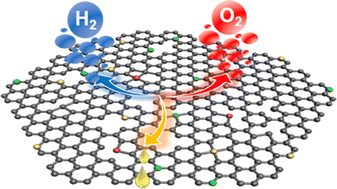Three-dimensional N, P, and O tri-doped porous carbon for multifunctional electrocatalytic reactions†
Abstract
With the gradual development of renewable energy technologies, developing metal-free carbon materials has attracted more attention as a new category of multifunctional electrocatalysts. Along with the deepening of the comprehension of the electrocatalytic nature, the electrocatalytic performance of carbon catalysts could be greatly regulated by embellishing with foreign atoms and pores. Herein, we synthesized a three dimensional N, P, O co-doped carbon framework (3D-NPOC) by using a simple annealing treatment with tannic acid as a precursor. Benefitting from the electronic structure optimization effect of foreign atoms and accelerated electrolyte transfer and gas diffusion derived from the interconnected 3D porous nanostructures, the obtained 3D-NPOC showed a relatively high ORR half-wave potential that is on a par with those of commercial Pt/C, delivered a comparable OER performance to IrO2, especially under high current densities, and also showcased comparatively good HER properties. More importantly, the obtained catalyst-based zinc–air batteries exhibited a comparable performance to Pt/C‖IrO2-based batteries.

- This article is part of the themed collection: Research advancing UN SDG 7: Affordable and clean energy


 Please wait while we load your content...
Please wait while we load your content...